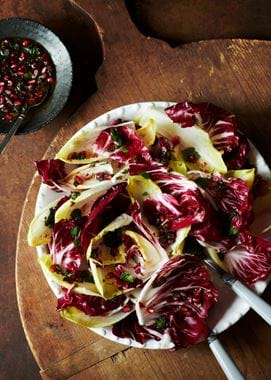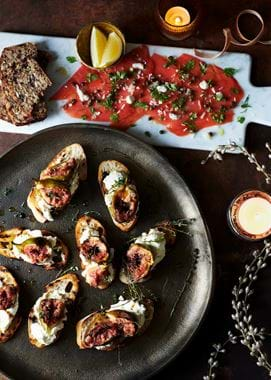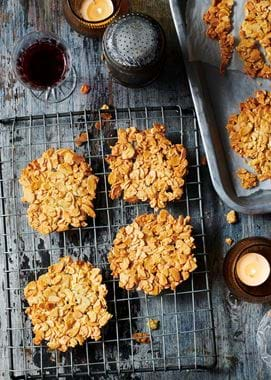Six not-too-fancy festive canapes
Six not-too-fancy festive canapes
When Christmas calls, it’s all too easy to get carried away with Christmas lunch, focusing most of your efforts on the turkey and the trimmings. But what about serving suggestions for Christmas Eve parties, Boxing Day buffets or New Year’s celebrations when you’re playing host?
Last year, Sam Wylde (one of our favourite local chefs from wholesome and heartfelt food brand, Sam’s Kitchen Events) cooked up a selection of smaller recipes for those moment when people drop in at Christmas and you want to give them a bite to eat made by your fair hands. This time, he’s prepared six more bite-size dishes that are welcome alternatives to fancy canapés, and has told us about the inspiration behind each one. They’re all colourful, seasonal, easy to make, and most importantly, delicious to eat.
Roasted red pepper & pecan dip with herby flatbreads
“Have you ever eaten Muhammara? If you haven’t, you’re in for a treat. This is my version of the Middle Eastern dip originating from Aleppo in Syria that I reckon is perfect with everything. It’s all about the texture and warmth here. Native Aleppo chilli flakes are slightly harder to get a hold of since the terrible conflict in Syria has forced growers to move north into Turkey, but they’re still out there. A great alternative would be Turkish Urfa chilli flakes which are a little hotter but a whole lot smokier and give an extra element to the flavour.”
Put aside: 20 minutes for prep and 45 minutes for cooking
Makes enough for: six–eight people
What you’ll need
For the dip
8 large red peppers
½ lemon juiced
2 tbsp pomegranate molasses
2 tsp ground cumin
½ tsp ground coriander
2 tbsp dried chilli flakes Aleppo or Urfa if you can
½ garlic clove peeled and roughly chopped
70g pecan nuts
100g fresh bread crumbs
3 tbsp olive oil plus a drizzle for the end
A pinch of sea salt flakes
A handful of fresh flat-leaf parsley
For the flatbreads
350g organic plain yoghurt
350g organic self-raising flour
1 tbsp baking powder
A handful of fresh coriander roughly chopped
A pinch of sea salt flakes
What to do
1 Start with making the dip. Turn up your oven to 220°C/425°F/gas mark seven.
2 Put the peppers on a parchment-lined baking tray and roast them whole for 30–35 minutes. Turn them a couple of times so they blacken all the way round.
3 Once they’re thoroughly roasted, put the peppers in a bowl and cover it with cling film, leaving them until they’re cool enough to handle but not cold. This should take about 20 minutes.
4 Peel away the skins and remove the seeds (don’t worry if a few seeds are still lurking – they’re harmless). And then put the peeled peppers and everything apart from the pecans into a food processor and blitz for 30 seconds. Add the pecans and salt, and pulse until you have a texture that you’re happy with. I like mine coarse and chunky. Set it aside until you’re ready to serve.
5 Now for the flatbreads. Combine everything but the coriander in a bowl and mix with a spoon until you have a nice dough. It should only take about a minute and will feel soft and sticky.
6 Throw in the chopped coriander, flour your hands so they don’t stick, and mix your dough by hand until everything is just combined.
7 Let the dough mix rest for 20 minutes (you can cover it with a tea towel if you want) and when you’re ready, heat a dry griddle pan or frying pan until it’s nice and hot.
8 With plenty of flour on your hands, surface and rolling pin, take a golf ball sized amount of dough and roll it out as thin as you can. As a guide, you should get about 15 flatbreads from the mixture, but it’s not a fine art.
9 Grill them on each side until they’re nicely cooked. Depending on how thick they are, it should be about three minutes per side.
10 Rip them up and serve them warm with a generous scoop of dip on each piece.
Sam’s serving suggestion
On the table
Cut the flatbreads into irregular sized pieces and scatter onto a breadboard. I put my dip in a pot on the same board and like to finish it off with a drizzle of good-quality extra virgin olive oil and a few picked parsley leaves.
As a canapé
Canapés need to always be small, so that you don’t feel that you need a plate to eat them. To serve these as a smaller morsel, still use a breadboard, but cut the flatbreads into roughly 4cm pieces and top each one with the dip, so they’re easy to pick up, ready loaded.
Sam says
The dip keeps well and, without doubt, tastes better the next day. Just remember to get it out of the fridge nice and early so it’s at room temperature when you serve it.
Bresaola & celeriac remoulade
“British charcuterie has come a really long way in the last ten years. If you can get to a deli near you to find a local producer, then I’d highly recommend it. You don’t have to use bresaola here – any cured meat will do. Try and get something with punch to stand up to the mustard flavour in the remoulade though, like coppa or even a lovely jamon. My favourite type of charcuterie for this remoulade is cecina de León. It’s a mouth-watering, cured and smoked beef from Spain. You can buy it from Brindisa in Borough Market or online.”
Put aside: 15 minutes for prep and 20 minutes resting time
Makes enough for: six–eight people
What you’ll need
24 pre-sliced pieces of Braseola
For the remoulade
½ lemon juiced
1 medium-sized celeriac
3 tbsp mayonnaise
3 tbsp crème fraiche
1 tbsp Dijon mustard
1 tbsp wholegrain mustard
1 tbsp fresh parsley finely chopped
1 tbsp fresh chervil finely chopped
A pinch of sea salt flakes and cracked pepper to taste
What to do
1 Find yourself a large mixing bowl and squeeze in the lemon juice.
2 Peel and shred the celeriac into strips (about the thickness of a matchstick). Don’t worry too much about the length of each piece though. Then, toss them in the bowl with the lemon juice – this stops them from discolouring and helps to soften them too.
3 In a separate bowl, combine all of the other ingredients and mix well with a whisk to make your sauce.
4 Combine the sauce with the celeriac and mix again gently to coat each matchstick.
5 Set aside the remoulade mixture for 30 minutes or so, out of the fridge, so that the flavours combine even more. Or longer, until you’re ready to serve.
Sam’s serving suggestion
On the table
Pick out a large, flat dish and lay out your Bresaola in pieces so that they cover the plate. Top with spoonfuls of the remoulade, and then throw over some picked herbs for colour.
As a canapé
Roll your Bresoala (or whichever cured meat you’re using) around a teaspoon full of the remoulade so that all people need to do is to lift a teaspoon and enjoy in one delicious mouthful.
Sam says
If you’re not keen on chervil or can’t get hold of it at your local grocer or supermarket, then the remoulade will be equally as delicious with some chives or even tarragon as a substitute. Unlike the roast pepper dip, remoulade doesn’t keep well overnight as it becomes limp and a little claggy in the fridge. It’s so quick to prepare that you can eat this one fresh.
Roasted fig, thyme and ricotta crostini
“I’m the biggest fan of anything on toast. Crostinis or bruschetta can be such a fab seasonal go-to for feeding last-minute guests something really special, with just a few ingredients. We buy our ricotta from Tom Calver at Westcombe Dairy, just down the road from us. His ricotta is unbelievable and easily the best I’ve tasted anywhere. He also makes a multi award-winning cheddar, which you can try alongside some beautiful craft beer and cider at his Somerset shop.”
Put aside: 15 minutes for prep and ten minutes for cooking
Makes enough for: six–eight
What you’ll need
For the crostini
1 loaf ciabatta sliced into roughly 1cm pieces
½ clove garlic cut widthways
A drizzle of olive oil
A pinch of sea salt flakes
For the fig and ricotta topping
300g ricotta cheese
16 ripe, medium-sized figs
1 tbsp muscovado sugar
3 sprigs of fresh thyme
A drizzle of olive oil
A drizzle of aged balsamic vinegar
A pinch of sea salt flakes to taste
A couple of fresh thyme sprigs to garnish
What to do
1 Turn up your oven to 180°C/350°F/gas mark four.
2 Line a baking tray with baking parchment and lay out your sliced ciabatta. Drizzle the bread with olive oil – just a few drops across each slice.
3 Now to the garlic. Because you won’t have peeled it, you can hold the skin to make it easier to rub the cut side to rub the oil and the garlic into each piece of crostini. Turn each piece over and repeat. You shouldn’t need any more oil but if you do need a little, it’s no problem. Sprinkle with a little salt at this stage too.
4 Heat a griddle pan until it’s nice and hot. Grill each piece of ciabatta for about three minutes on each side or until you have nice, dark grill marks but they’re still a little soft in the middle. If you don’t have a griddle pan, then you can quite happily bake the sliced ciabatta in the oven for around six–eight minutes. You can leave your bread in the oven while you prepare the figs.
5 Line another baking tray with baking parchment. With the stalk facing up, cut the figs about half way down from top to bottom and then gently pull open so they remain as one piece – this means they’re butterflied.
6 Sprinkle each section of fig with a pinch of sugar and some fresh thyme leaves.
7 Bake the figs in the oven for six–eight minutes, or until they’re soft and the sugar has started to lightly caramelise. Once they’re done, take them out so they can cool down.
8 Take a single crostini and spread generously with ricotta. Lift one on the cooled fig sections and place it on top of the ricotta.
9 Drizzle every piece with a drop of thick, aged balsamic, a little more olive oil, and a little salt.
Sam’s serving suggestion
On the table
As with all of these dishes, they’re meant for sharing. A nice big wooden board or flat dish will be best for these, and scatter them with sprigs of fresh thyme.
As a canapé
You can cut the crostini into smaller pieces so they’re more bite-size canapé size. Just be sure to cut the figs into smaller pieces too so that every slice of ciabatta has a bit of every topping. Scatter the canapés with thyme leaves rather than whole sprigs or they’ll just get in the way.
Sam says
Ciabatta works really well for the crostini as it’s such a light and moist bread made with olive oil in the baking process. Sourdough will also work well as a denser and more flavoursome version, but to be honest you can use whichever bread you have in the bread bin – even if it’s a little stale.
Smoked salmon, shallots, capers, horseradish cream and rye bread
“This is a really quick way to add another level of flavour to smoked salmon. It’s delicious not just as a canapé, but as a brunch, supper or as part of that festive buffet table for all of your family to enjoy. Personally, I always use organic salmon and I buy it from my local fishmonger rather than from a big supermarket.”
Put aside: 15 minutes for prep
Makes enough for: six–eight people
What you’ll need
For the salmon
300g smoked salmon
1 tbsp capers in vinegar try Lilliput capers – they’re small and packed full of flavour
1 tbsp banana shallots finely diced
1 tbsp dill picked from the stem
A pinch of sea salt flakes
A drizzle of olive oil
1 loaf of seeded rye bread
For the horseradish cream
50g horseradish root peeled and finely grated
50g crème fraiche
1 tsp red wine vinegar
A pinch of sea salt flakes
What to do
1 To make the horseradish cream, peel and then finely grate the horseradish root, ideally with a microplane or garlic grater. If you don’t have one, then the finest side of your grater will do – basically, the finer the better!
2 In a small mixing bowl, combine the grated horseradish with the crème fraiche and whip lightly with a whisk or fork.
3 Add the red wine vinegar and salt, stirring them through.
4 Now to put the dish together. Carefully take the salmon from its packaging, keeping each slice whole. Arrange it on a board or flat dish in one layer. Take the capers from the jar, drain any excess liquid and sprinkle them over the salmon with your fingertips.
5 Follow by doing the same with the diced shallots.
6 Next, pull the fine strands of dill from the thick stalk – you should end up with roughly fingertip-sized pieces. Sprinkle them over the salmon too.
7 Back to the horseradish cream. Give it a quick stir when it’s out of the fridge and then take a teaspoon in each hand. With one, scoop about 1/3 of a teaspoon out of the bowl. Then using the other teaspoon, gently scrape it onto the salmon – it makes things look a little nicer than dolloping it on. Continue to do this until you have around ten little dots of cream across the salmon.
8 Pinch the coarse salt over the salmon and flick a little olive oil over to add some sheen.
9 Slice the rye bread nice and thin, and serve alongside the salmon for people to help themselves.
Sam’s serving suggestion
On the table
Exactly as the recipes describes – on the table, you want it all spread out ready to be admired and ready for everyone to dig in.
As a canapé
We often use this as a canapé at dinner parties, weddings and any other events. Cut a little square of rye bread and build a smaller version of the salmon plate on top of it. A dot of horseradish cream and a little leaf of dill should be the last two things on the top.
Sam says
If your local supermarket or deli doesn’t sell the Lilliput capers, you can of course use ordinary capers in vinegar or brine. It’s the salty punch of the capers combined with the sweetness of the shallots that really make this dish. The quantities for the horseradish cream above will definitely give you leftovers, perfect for roast beef next Sunday!
Winter salad with toasted hazelnuts, pomegranate & mint pesto, and flat leaf parsley
“Winter leaves are full of colour, flavour and a delicious natural bitterness which can really add to a well-balanced and considered salad, moving it away from just another plate of leaves. At your local food market or greengrocer, make sure you pick up what you want to buy. Smell it and squeeze it gently to test its firmness so you’re happy it’s as fresh as can be.”
Put aside: 20 minutes for prep
Makes enough for: six–eight people
What you’ll need
For the salad
1 head radicchio
2 heads chicory
2 tbsp hazelnuts
A small bunch of fresh flatleaf parsley leaves left whole
For the pomegranate and mint pesto
3 tbsp pomegranate seeds
1 tbsp pomegranate molasses
50ml olive oil
2 tbsp fresh mint leaves finely chopped
A pinch of sea salt flakes
¼ lemon juiced
1 tsp red wine vinegar
What to do
1 Turn up your oven to 180°C/350°F/gas mark four.
2 Add all the pesto ingredients to a mixing bowl and whisk lightly to combine them. Then set it aside until later on.
3 Get rid of any damaged outer leaves from the radicchio – you just want the good stuff inside. Stand it on its stalk and cut it in half from top to bottom. Lay each half on its flat side and cut again so you have wedges. And then cut the hard stalk away at an angle.
4 Now fill a large mixing bowl with cold water. Gently pull the radicchio leaves from each other, and dunk them in water for five minutes. Swill them around so they’re thoroughly cleaned. Drain them and shake them (use a salad spinner if you have one) so there’s as little water on them as possible.
5 For the chicory, you’ll need to follow a similar process. Remove any damaged outer leaves and cut off the hard root (about 1cm at the bottom). Some of the leaves should fall away freely, but just follow these steps again until all the leaves have fallen away.
6 Rinse all of the chicory leaves under a cold tap and pat them dry with a clean tea towel.
7 Line a baking tray with baking parchment and add your hazelnuts on top. Toast them in the oven for around six minutes or until the hazelnuts are lightly golden. Put them into a pestle and grind them four or five times. Some will be crumbs, some will be in chunks and some should still be whole.
8 Take a low salad dish and build your salad leaves using the radicchio and chicory.
9 Stir the pesto with a tablespoon and then dress the leaves using a spoonful at a time with a scattering of hazelnuts and parsley to finish.
Sam’s serving suggestion
On the table
This one’s more about a help-yourself dish than a canapé. Layering here is key. You want to build your salad, again on a relatively flat dish to give it texture and vibrancy. The colours of this salad are striking and it’s such a fab centrepiece to a lovely festive table.
Sam says
This is a vegan-friendly salad, perfect as a side dish to a main meal or as part of a Boxing Day buffet table. You could add some creamy Mountain Gorgonzola just before the parsley to make it a lunch time delight. If the bitterness is a little too much, you can leave the radicchio to soak in water for 30 minutes; the chemical makeup of the leaf that makes it bitter is water-soluble, so this helps to mellow it out.
Almond, orange and cinnamon Florentines
“Almonds, orange, cinnamon – it doesn’t get much more Christmassy than these super-quick, gluten-free biscuits. They’re light, crispy and not overly sweet which ticks all the boxes for me.”
Put aside: 20 minutes for prep and 12 minutes for cooking
Makes enough for: 16 biscuits
What you’ll need
25ml vegetable oil for brushing
3 free-range egg whites
150g icing sugar sifted
390g flaked almonds
1½ oranges finely grated
½ tsp ground cinnamon
What to do
1 Preheat your oven to 150°C/302°F/gas mark four.
2 Line two or three baking sheets with baking parchment, lightly brushing each one with oil.
3 Add all the ingredients to a bowl and mix them gently with a fork until they’re well-combined.
4 Then, fill a small bowl with water. Wet your fingertips and take a heaped teaspoon amount of mixture at a time to pop onto the baking tray. Space them apart and use a fork, dipped in the water, to gently flatten each portion as thinly as you can, without too many gaps between the flakes of almond. Each Florentine should be roughly 8–10cm in diameter.
5 Place the baking sheet in the oven for about 12 minutes, or until the biscuits are golden brown all over. You can gently lift one to make sure they’re cooked through.
6 Leave them to cool and then gently remove each biscuit from the tray using a palette knife or thin spatula. Keep them in an airtight container and they should last for up to seven days.
Sam’s serving suggestion
On the table
I like to stack them really high. It makes a brilliant focal point on your table.
As a canapé
Canapés don’t have to be all about savoury. I like to add at least one sweet variety to the mix. To make them look more rustic and tempting, you could pass them around in a tin lined with baking parchment, so that when people pick one out, they’re reminded of the fact they’re homemade.
Sam says
Traditionally, a Florentine has a chocolate bottom. Once cooled you can brush the biscuits with melted dark chocolate if you like.










